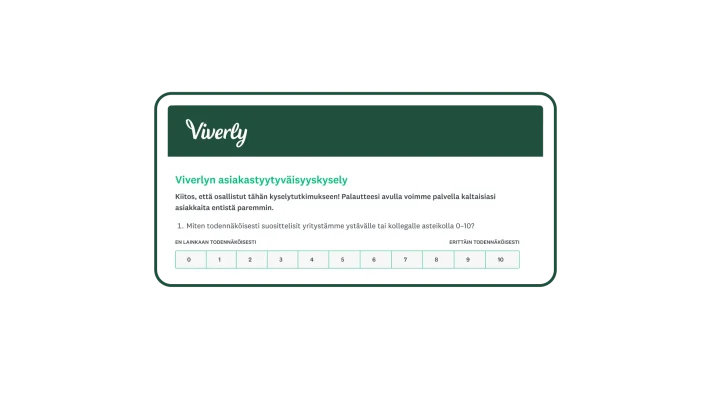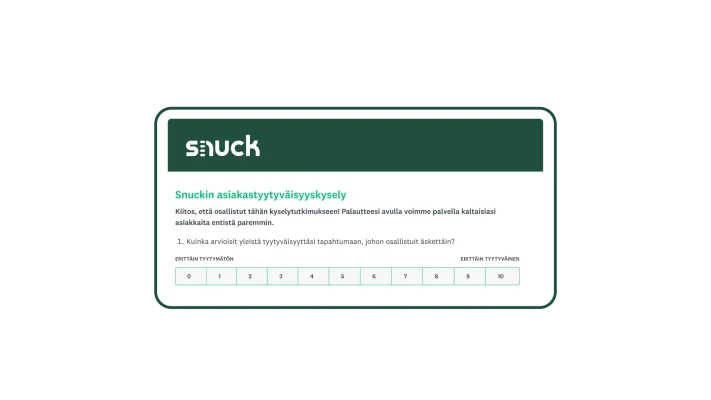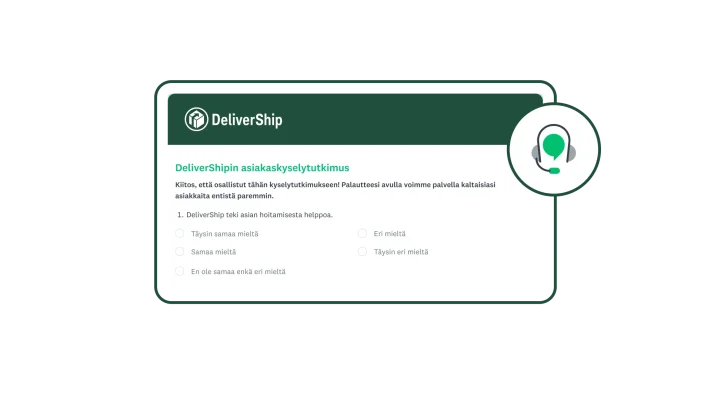Näin toteutat onnistuneen Asiakkaan ääni ‑ohjelman

Oletko koskaan vältellyt jotakin brändiä tai yritystä jonkin kuulemasi asian tai kokemasi pettymyksen vuoksi?
Entä kuinka usein olet kertonut näille yrityksille, miksi päätit lopettaa asioinnin niiden kanssa?
Jos työnkuvaasi kuuluu asiakaskokemuksen parantaminen, et voi odottaa kuluttajien kääntyvän puoleesi omatoimisesti, vaan sinun on ryhdyttävä toteuttamaan organisaatiossasi Asiakkaan ääni ‑ohjelmaa.
Asiakkaan ääni ‑ohjelma
Asiakkaan ääni määritellään tuotteesi, palvelusi tai brändisi kanssa asioinnista syntyvien kokemusten järjestelmälliseksi keräämiseksi, analysoinniksi ja seuraamiseksi.
Asiakkaan ääni ‑ohjelma on tärkeä osa koko asiakaskokemusta, sillä se merkitsee sitoutumista asiakaspalautteen perusteella tehtäviin toimenpiteisiin. Ensisijainen tavoitteesi on täyttää asiakkaiden odotukset korjaamalla puutteet yrityksen toiminnassa. Tehokkaalla Asiakkaan ääni ‑ohjelmalla työntekijäsi saavat valmiudet ylittää asiakkaiden odotukset.
Asiakkaan ääni ‑ohjelma vs. asiakaspalautteen kerääminen
Useat organisaatiot pyytävät asiakkailta palautetta kyselytutkimuksilla, palautelomakkeilla ja kohderyhmissä. Asiakkaan ääni ‑ohjelma ei kuitenkaan ole tavanomainen palautteenkeräystapa, sillä se asettaa asiakkaiden sitoutumisen sekä asiakasuskollisuuden ja ‑tyytyväisyyden yritysstrategian keskiöön. Hyvät Asiakkaan ääni ‑ohjelmat koostuvat seuraavista:
- vankat liiketoimintatavoitteet
- johtoportaan tuki
- työntekijöiden osallistuminen ja yhteistyö
- selkeä käsitys asiakaspolusta
- ennakoiva asiakkaiden kuuntelu kaikilla kanavilla ja kaikissa kontaktipisteissä
- säännöllinen asiakas- ja markkinatutkimus
- data-analyysit ja raportit
- sisäinen viestintä.
Tärkeintä kuitenkin on, että Asiakkaan ääni ‑ohjelma on sovellettavissa käytäntöön. Yritykset priorisoivat palauteprosessin hoitamisen loppuun asti etsimällä kipukohdat, korjaamalla ongelmat sekä kertomalla tehdyistä muutoksista niin työntekijöille kuin asiakkaille.
Tässä artikkelissa kerromme, kuinka voit luoda oman Asiakkaan ääni ‑ohjelman suunnittelusta ja käyttöönotosta ylläpitämiseen. Saat avuksesi vinkkejä, tärkeitä Asiakkaan ääni ‑mittareita ja näiden Asiakkaan ääni ‑kyselytutkimusmallien kaltaisia materiaaleja.
Näin luot Asiakkaan ääni ‑ohjelman
1. Varmista johtoportaan tuki Asiakkaan ääni ‑ohjelmalle
Uuden Asiakkaan ääni ‑ohjelman luominen tai nykyisen päivittäminen vie aikaa ja voimavaroja. Kokoa aluksi seuraavat tiedot ja keskustele johtajien kanssa varmistaaksesi kaikkien tuen:
- Osoita asiakkaiden suurimmat kipukohdat tai huolestuttavat mittarit (esimerkiksi 5 %:n kasvu asiakasvaihtuvuudessa edellisvuoteen verrattuna).
- Ehdota sisältöä uuteen tai nykyiseen Asiakkaan ääni ‑ohjelmaan.
- Esittele muiden yritysten tapaustutkimuksia, joissa korostetaan asiakkaiden kuuntelemista ja sen perusteella tehtäviä toimenpiteitä. Esimerkki: Greyhound-bussiyhtiö paransi tärkeää asiakasuskollisuuden mittaria 15 pisteellä ja teki asiakaskokemukseen merkittäviä kannattavuutta parantavia muutoksia.
2. Aseta tavoitteet yhdessä sidosryhmien kanssa
Kun olet saanut johtoportaan tuen, tee yhteistyötä yrityksen eri tiimien kanssa. Kullakin sidosryhmällä on omat näkemyksensä asiakaskokemuksesta sekä erilaisia ehdotuksia sen parantamiseksi.
- Koska asiakkuuspäälliköt tai asiakaspalvelijat ovat suoraan yhteydessä asiakkaisiin, he ymmärtävät tuotteidesi ja palvelujesi suurimmat kipukohdat ja ongelmat.
- Markkinointi- ja viestintätiimit voivat antaa havaintoja ja näkemyksiä kilpailijoista ja markkinoista, minkä lisäksi he saattavat keskustella kuluttajien kanssa sosiaalisessa mediassa.
- Myyntiosastolla on hyvä käsitys hintaherkkyydestä, kilpailijoiden tuotteista ja ratkaisuista sekä mahdollisia asiakkaita houkuttelevista viesteistä.
- Tuotetiimit voivat kertoa tuotteesi tai palvelusi käyttötavoista ja virheistä sekä siitä, miten usein asiakkaasi hylkäävät ostoskorinsa tai koko yrityksesi. Näin voit saada kattavan käsityksen tuotteidesi toimivuudesta ja mahdollisista asiakastyytyväisyyteen vaikuttavista ongelmista.
- Henkilöstöhallinto osaa kertoa työntekijäkokemuksesta, työntekijöiden sitoumuksesta sekä työntekijöiden valmiuksista vaikuttaa asiakaskokemukseen myönteisellä tavalla.
Kullakin tiimillä voi olla erilaiset tavoitteet tai erilainen käsitys menestyksestä, mutta pääset alkuun valitsemalla yhden tavoitteen koko yritykselle (esimerkiksi ”parannamme asiakastyytyväisyyttä 10 %”) ja kannustamalla kutakin tiimiä asettamaan oman tavoitteensa.
Muista, että asiakaskeskeisyys on tärkeintä. Esimerkiksi tuotetiimi saattaa haluta parantaa perehdytyskokemusta lisätäkseen rekisteröityneiden käyttäjien määrää, mutta Asiakkaan ääni ‑ohjelmassa tuote- ja asiakaspalvelutiimit kannattaa tuoda yhteen. Asiakaspalvelu voisi esimerkiksi tuoda esiin perehdytyskokemuksen kipukohdat ja tuotetiimi voisi korjata ne pyrkimällä siten vähentämään tukipyyntöjen määrää.
3. Luo asiakaspolun kartta
Keskustele tärkeiden sidosryhmien kanssa siitä, kuinka asiakas tai mahdollinen asiakas asioi brändisi kanssa ennen ostoksen tekemistä, ostoksen tekemisen aikana ja ostotapahtuman jälkeen. Tällainen asiakaspolun kartoittaminen voi auttaa löytämään tilaisuuksia palautteen keräämiseen, tiettyihin kipukohtiin perehtymiseen tai asiakaskokemuksen puutteiden korjaamiseen. Asiakkaiden kontaktipisteitä esiintyy tavallisesti seuraavissa asiakaspolun vaiheissa:
- ennen ostosta: mainonta, suosittelut, sosiaalinen media
- ostoksen aikana: verkkosivusto, myymälä, myyntipiste
- ostoksen jälkeen: laskutus, ostokseen liittyvät sähköpostit, ohjekeskus verkossa.
Asiakaspolun kartassa tulisi myös huomioida, milloin, missä ja miten usein asiakaspalautetta pyydetään. Näin osaat hioa kyselytutkimustesi suunnittelua ja seurantaa.
Tarvitsetko apua asiakaspolun kartan luomiseen?
Katso, kuinka voit saada sidosryhmät yhteisen asian taakse ja saavuttaa liiketoimintatavoitteesi luomalla asiakaspolun kartan.
4. Kuuntele asiakkaita säännöllisesti
Asiakkaiden kuunteleminen tarkoittaa jäsennellyn ja jäsentelemättömän (määrällisen ja laadullisen) palautteen keräämistä Asiakkaan ääni ‑ohjelmassa.
Jäsennelty data on määrällistä ja mitattavissa. Sanotaan esimerkiksi, että pyydät kyselytutkimuksessa asiakkaita arvioimaan, millä todennäköisyydellä he ostavat tuotteitasi uudelleen tulevaisuudessa. Kun pyydät heitä valitsemaan annetuista vaihtoehdoista, tuloksilla on numeerinen arvo: 76 % asiakkaista vastaa tekevänsä ostoksen uudelleen.
Jäsentelemätön data on laadullista, eikä sitä voi mitata. Esimerkiksi ostokokemusta arvioivassa kyselytutkimuksessa voit pyytää vastaajia kertomaan tekstiruudussa, miksi he ”hyvin todennäköisesti” ostaisivat tuotteitasi uudelleen. Tekstivastaukset auttavat selvittämään saamiesi tulosten syyt.
Saat kattavan kuvan asiakaskokemuksesta, kun keräät kummankinlaista tietoa. Näin voit kuunnella asiakkaitasi säännöllisesti tehokkaassa Asiakkaan ääni ‑ohjelmassa:
- Varmista, että keräät palautetta asiakastyytyväisyyskyselyillä tärkeissä asiakkaiden kontaktipisteissä, kuten asiakkaan tehtyä ostoksen tai asioidessa asiakaspalvelun kanssa.
- Kannusta yrityksen kaikkia tiimejä pitämään kokouksia esimerkiksi myyntiosaston ja asiakaspalvelun kanssa neljännesvuosittain.
- Tee säännöllisesti asiakas- tai käyttäjätutkimusta saadaksesi havaintoja kilpailijoista ja osataksesi parantaa tuotteitasi ja palvelujasi.
- Järjestä kohderyhmiä ja asiakashaastatteluja saadaksesi syvällisempiä näkemyksiä.
- Seuraa keskustelua sosiaalisessa mediassa saadaksesi selville, kuinka bändiisi suhtaudutaan.
5. Seuraa tärkeitä Asiakkaan ääni ‑mittareita
Yritykset voivat selvittää asiakaskokemusta alan standardien mukaisilla Asiakkaan ääni ‑mittareilla. Tässä ovat suosituimmat Asiakkaan ääni ‑mittarit.
Net Promoter Score (NPS)

Jos haluat tietää, kuinka todennäköisesti yritystäsi suositeltaisiin ystävälle tai kollegalle, saat määrällisen ja helposti seurattavan vastauksen Net Promoter Score® (NPS) ‑kyselytutkimuksella. Tässä on yleiskatsaus NPS-kyselytutkimuksesta.
- Yksinkertainen NPS-laskelma: osallistujat antavat arvionsa nollan ja kymmenen väliltä, ja tulokseksi saadaan luku −100:n ja +100:n väliltä.
- Seurattava ja kätevä: voit hyödyntää suoraviivaista Net Promoter Score ‑kysymystä monipuolisissa tilanteissa, kuten kysyessäsi suosittelisivatko vastaajat esimerkiksi brändiäsi, sovellustasi tai ohjelmistoasi. Koska NPS-kysymys ei ole sidottu tiettyyn tapahtumaan, se kuvaa hyvin organisaatiosi suoritusta kaikissa tilanteissa.
- Hyödylliset alan vertailuarvot: koska useat organisaatiot käyttävät NPS-kysymystä, voit verrata toimintaasi alasi muihin toimijoihin. Esimerkiksi satojen NPS-kyselytutkimusten analyysimme osoittaa, että terveydenhoitoalalla keskiarvo on 38.
Asiakastyytyväisyyspisteet

NPS kertoo asiakasuskollisuudesta ajan mittaan, kun taas asiakastyytyväisyyspisteet antavat käsityksen siitä, miltä asiakkaasta tuntuu asioituaan brändisi kanssa. Tässä on hyödyllistä tietoa asiakastyytyväisyyden kyselytutkimuksista.
- Ne toimivat hyvin NPS:n kanssa. Niin asiakastyytyväisyyspisteet kuin NPS ovat tärkeitä Asiakkaan ääni ‑mittareita, jotka antavat erilaisia ja toisiaan täydentäviä havaintoja asiakaskokemuksesta.
- Ne ovat täsmällisiä ja käyttökelpoisia. Asiakastyytyväisyyden kyselytutkimusten perusteella voidaan tehdä kohdistettuja parannuksia asiakaskokemukseen. Voit kerätä palautetta asiakaspalvelusta tai mitata osallistujien tyytyväisyyttä pyytämällä palautetta tapahtumista.
- Niistä on helppo tehdä laskelmia ja analyysejä. Vastausvaihtoehdot asiakastyytyväisyyden kyselytutkimuksissa perustuvat numeeriseen asteikkoon, esimerkiksi 1–5. Voit esittää raakalukuja sanomalla esimerkiksi, että 478 asiakasta ilmoitti olevansa ”hyvin tyytyväinen” äskettäiseen asiointiinsa asiakaspalvelun kanssa, tai voit esittää datan prosenttilukuna.
Työläys asiakkaalle

Jos haluat tietää, kuinka helppoa tai vaikeaa asiakkaiden on hoitaa tiettyjä tehtäviä asioidessaan yrityksesi kanssa, työläys asiakkaalle auttaa selvittämään asiakkaiden kipukohdat esimerkiksi ohjelmistojen käytössä tai ongelmanratkaisussa. Seuraavista syistä Asiakkaan ääni ‑ohjelmassa kannattaa käyttää asiakkaille aiheutuvaa työläyttä mittaavia kyselytutkimuksia.
- Ne lujittavat asiakasuskollisuutta. Tutkimuksemme mukaan 91 % kuluttajista todennäköisesti suosittelee yrityksiä, kun asiointi ei ole vaatinut liikaa vaivaa.
- Ne tarjoavat nopeita tapoja tehdä parannuksia. Asiakkaat saattavat jättää ostoksen tekemättä epäselvien ohjeiden vuoksi, mutta jo esimerkiksi maksuvaiheen sanamuodon muuttaminen voi parantaa yrityksen tulosta.
- Ne auttavat luomaan parempia koulutusohjelmia. Työläyttä mittaavilla kyselytutkimuksilla voit selvittää esimerkiksi, missä kohdin asiakaspalvelun toiminta mahdollisesti ontuu. Kun ymmärrät asiakkaiden kohtaamat vaikeudet, voit ratkaista tavallisia ongelmia nopeasti muuttamalla asiakaspalvelukoulutusta.
6. Analysoi tulokset
Kun alat kerätä asiakaspalautetta eri kontaktipisteissä, sinun on tutkittava ja verrattava kutakin tietojoukkoa.
- Pyydä yrityksesi muilta osastoilta asiakashavaintoja, joita ne ovat keränneet esimerkiksi markkinatutkimuksesta ja sosiaalisen median kanavilta, ja kokoa kaikki tiedot yhteen paikkaan yrityksessäsi.
- Jotkin ylätason tiedot, kuten Net Promoter Score ‑tulos, on helppo käsittää sellaisenaan, mutta asiakaskyselytutkimusten avoimesta palautteesta saatavat suuntaukset kannattaa selvittää tekstianalyysityökalulla.
- Kyselytutkimusdata kannattaa pilkkoa osiin muokattavien datasuodattimien kaltaisilla edistyksellisillä työkaluilla, jotka voivat auttaa poimimaan kyselytutkimustuloksista syvällisiä asiakashavaintoja.
7. Toimi ja toista
Kun olet luonut asiakaspalautestrategian, sinun kannattaa huomioida ja hoitaa kaikki tärkeimmät ongelmakohdat, kuten heikkenevä NPS-tulos tai huonot asiakastyytyväisyyspisteet.
Asiakkaan ääni ‑ohjelman ylläpitämiseen kannattaa luoda vankat pitkän tähtäimen puitteet esimerkiksi näin:
- Muuta tuotesuunnitelmia: tuotetiimit voivat sitoutua korjaamaan muutaman kiireellisimmän asiakasongelman kunkin neljännesvuoden aikana.
- Paranna asiakaspalvelun koulutusta ja reagointia: palvelutiimit voivat priorisoida työntekijöiden perehdytyksen sekä empatiakoulutuksen tai lyhentää vastausaikaa luomalla valmiit vastaukset asiakkaiden yleisimpiin kysymyksiin.
- Innosta koko yritys mukaan: kannusta työntekijöitä puolivuosittain keskittymään asiakkaiden ongelmien ratkaisemiseen tai asiakkaiden palautteeseen vastaamiseen.
- Pidä asiakkaat toimintasi keskiössä: pyydä asiakkailta palautetta säännöllisesti.
- Kerro epäonnistumisista ja onnistumisista: lähetä työntekijöille motivoiva kuukausiraportti, joka sisältää esimerkiksi saadun palautteen, datasuuntauksia ja asiakastarinoita.
Asiakkaan ääni ‑ohjelman edut
Vaikka tyytyväiset asiakkaat todennäköisesti pysyvät uskollisina brändillesi ja suosittelevat sitä muillekin, Asiakkaan ääni ‑ohjelmat tuovat myös muita etuja.
Paranna työntekijöiden sitoutumista
Asiakkaan ääni ‑ohjelmassa työntekijät saavat vaikuttaa asiakaskokemukseen suoraan. Voit esimerkiksi kannustaa tiimejä asettamaan asiakaskeskeisiä tavoitteita ja palkita niiden saavuttamisesta.
Edistä kilpailuetua
Palautetta keräämällä saat yleensä käsityksen asiakkaiden tuntemuksista vasta asiointitilanteiden jälkeen. Asiakkaan ääni ‑ohjelmassa palautetta kerätään sen sijaan myös ennakoivasti esimerkiksi kohderyhmissä, asiakashaastatteluissa, sosiaalisessa mediassa ja käyttäjätutkimuksissa. Näin saat tilaisuuksia esimerkiksi uusien tuoteideoiden kehittämiseen ja asiakkaiden kipukohtien ratkaisemiseen.
Kerää käyttäjäkokemuksia ja luo sosiaalista vahvistusta
Myönteisen asiakaspalautteen ja asioinnin perusteella voit kertoa vaikuttavia tarinoita brändistäsi eri kanavilla, kuten mainoksissa, verkkosivustollasi tai sosiaalisen median alustoilla.
Näin nujerrat Asiakkaan ääni ‑ohjelmien yleiset haasteet
1. haaste: asiakaspalaute- ja datasiilot
Kaikista kontaktipisteistä kerätty asiakasdata antaa kokonaiskuvan asiakaskokemuksesta, mutta yksittäisten tiimien käyttöön jäävät tiedot eivät auta tuomaan esiin suuntauksia tai hyödyllisiä liiketoimintatilaisuuksia.
Varmista, että kaikki sidosryhmät tai tiimit joko raportoivat löydöksistään tai jakavat kaiken datan samassa paikassa. Voit helpottaa palautteen keräämistä ja hallintaa kyselytutkimusten integraatioilla, joita on saatavilla esimerkiksi Salesforcelle, HubSpotille, Mailchimpille, Zendeskille ja Zoomille.
2. haaste: asiakkaat eivät vastaa palautekyselytutkimuksiin
Jos kyselytutkimuksiin saamasi vastausmäärä ei tuo esiin tilastollisesti merkitseviä tuloksia, voit verrata Asiakkaan ääni ‑ohjelmassa käyttämiäsi kyselytutkimuksia parhaiden käytäntöjen tarkastuslistaan.
Koska liian pitkät tai monimutkaiset kyselytutkimukset eivät kiinnosta asiakkaita, sinun kannattaa käyttää asiantuntijoiden tekemiä kyselytutkimusmalleja ja asiakastyytyväisyyskysymyksiä saadaksesi tarpeeksi vastauksia.
Jos tarvitset lisäapua, tutustu näihin asiakastyytyväisyyskyselyn vastausprosenttia kasvattaviin vinkkeihin ja asiakastyytyväisyyskyselyiden parhaisiin käytäntöihin.
3. haaste: kaikki tiimit eivät halua tukea pyrkimyksiäsi
Esitä asiakastyytyväisyyden vaikutus yrityksen tulokseen, jos et muuten saa tiimejä asettamaan asiakasongelmien ratkaisemista etusijalle. Voit esimerkiksi osoittaa asiakastyytyväisyyden parantavan tuottoa investoinneille kytkemällä sitoutuneiden asiakkaiden koko asiakaspolun arvo niiden asiakkaiden määrään, jotka sanovat tekevänsä ostoksen uudelleen.
Todista näkökulmasi kertomalla vastahakoisille tiimeille esimerkiksi tutkimuksestamme, jonka mukaan 75 % asiakkaista lakkaa luottamasta yritykseen huonon tuotekokemuksen jälkeen.
Näin luot Asiakkaan ääni ‑ohjelman
Suunnittele asiakkaiden asenteita keräävä Asiakkaan ääni ‑ohjelma seuraavien parhaiden käytäntöjen mukaan, niin otat asiakkaat mukaan keskusteluun, saat sidosryhmien tuen ja luot vaikuttavaa muutosta.
- Huomioi hiljainen tieto. Tällaista on esimerkiksi sovellusten käyttöön tai asiakasvaihtuvuuteen liittyvä sanaton tieto. Tiedät tarvitsevasi asiasta lisätietoa, kun asiakas sanoo pitävänsä sovelluksestasi, vaikka lopettaa sen käytön.
- Siivoa kyselytutkimusdata ennen analysointia, niin saat virheettömiä ja käyttökelpoisia tuloksia.
- Mitä tyytyväisempiä työntekijäsi ovat, sitä parempia asiakaskokemukset ovat. Seuraa työntekijöiden sitoutumista ja tyytyväisyyttä yhdessä henkilöstöhallinnon kanssa esimerkiksi eNPS-kyselytutkimuksella. Voit tarkkailla ja seurata muitakin tärkeitä työntekijöiden sitoutumisen mittareita ja verrata esimerkiksi työntekijöiden NPS-tulosta asiakkaiden NPS-tulokseen.
- Anna tuloksille kontekstia sekä seuraamalla asiakastyytyväisyyttä ajan mittaan että vertaamalla tuloksiasi kilpailijoihin. Näin saat kattavan kokonaiskuvan suoriutumisestasi.
- Pidä Asiakkaan ääni ‑ohjelma ajan tasalla. Perehdy tärkeimpiin asiakaskokemuksen suuntauksiin, kuten siihen, kuinka asiakaskokemuksen ammattilaiset luovivat tekoälyn maailmassa ja vastaavat kuluttajien alati muuttuviin odotuksiin.
Ryhdy luomaan Asiakkaan ääni ‑ohjelmaa jo tänään
Lähetä kyselytutkimus muutamassa minuutissa asiantuntijoiden tekemien Asiakkaan ääni ‑kyselytutkimusmallien pohjalta. Jos tarvitset lisäapua, SurveyMonkey voi tehostaa Asiakkaan ääni ‑ohjelmaasi.
Net Promoter, Net Promoter Score ja NPS ovat Satmetrix Systems, Inc:n, Bain & Company, Inc:n ja Fred Reichheldin tavaramerkkejä.
Tutustu muihin materiaaleihin

Asiakastyytyväisyyttä mittaavat kyselytutkimusmallit
Tutustu asiakastyytyväisyyttä mittaaviin kyselytutkimusmalleihimme, niin voit nopeasti kerätä dataa, löytää epäkohdat ja parantaa asiakaskokemusta.

Katso, kuinka Ryanair kerää asiakashavaintoja laajassa mittakaavassa
Katso, kuinka Ryanair seuraa asiakastyytyväisyyskyselyitä ja parantaa asiakaskokemusta SurveyMonkeylla ja Microsoft Power BI ‑integraatiolla.

Katso, kuinka woom parantaa työntekijä- ja asiakaskokemusta
Katso, kuinka Surveymonkey auttaa woomia toteuttamaan monikielisiä kyselytutkimuksia, parantamaan työntekijäkokemusta ja keräämään asiakaspalautetta.

Katso, miksi Together Labs kerää käyttäjien mielipiteitä SurveyMonkeylla.
Lue, miksi Together Labs luopui Google Formsista ja vaihtoi SurveyMonkey Enterpriseen kerätäkseen perusteellista käyttäjäpalautetta.